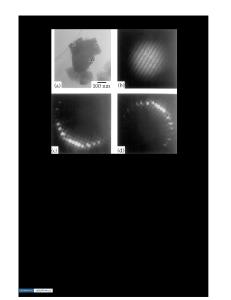High-performance Ni 3 Al synthesized from composite powders
- PDF / 2,533,717 Bytes
- 8 Pages / 598.28 x 778.28 pts Page_size
- 11 Downloads / 342 Views
I.
INTRODUCTION
THE intermetallic compound Ni3AI (3") has demonstrated extraordinary properties, such as high melting point, high ordering energy, thermal hardening, good resistance to oxidation, and relatively small density, t~,2j These properties make this compound attractive for aerospace and structural applications at elevated temperatures. In particular, the problem of intrinsic brittleness at ambient temperature has been eliminated by microalloying with B (0.1 wt pct). tl,2,3j However, the superalloy used in turbine industries has not been replaced by Ni3A1. The major problem in manufacturing is the strong tendency of AI to oxidize at elevated temperatures, which causes metal-crucible and metal-ceramic interactions during vacuum melting and vacuum investment casting, respectively, as during the regular processing for turbine blades. One approach to avoid these interactions is to fabricate the Ni3A1 components in their net shape by powder metallurgy (PM) techniques. Indeed, many studies of this material have been conducted on a hot isostatic press (HIP) and vacuum hot press (HP). 14,5,6~Other works on the vacuum reaction sintering t4-sl and the combustion synthesis t9,1~ of elemental Ni and AI powders under vacuum or a protective atmosphere have also drawn much attention. However, few articles from those PM studies have made a thorough comparison of the tensile or other mechanical properties at either ambient or elevated temperatures. In order to fabricate a specimen of reasonable size without expensive HIP or HP facilities, particles of pure AI must be protected before handling. Therefore, our objective is to demonstrate that a high sintering density and specimens of relatively large dimensions of Ni3A1 + B WEN-CHIH CHIOU, Ph.D. Student, and CHEN-TI HU, Professor, are with the Department of Materials Science and Engineering, National Tsing Hua University, Hsinchu 30043, Taiwan, Republic of China. Manuscript submitted May 18, 1993. METALLURGICAL AND MATERIALS TRANSACTIONS A
can be fabricated through replacing plating and electroless Ni-B plating of A1 powder, and through common sintering. To adjust the B content of the material to 0.1 wt pct, a suitable amount of fine pure Ni powder has been added to and mixed with the Ni-B-A1 composite powder in the final stage of electroless plating. Our resuits demonstrate that a high density (99.3 pc0, high yield strength (-550 MPa), good ultimate tensile strength (UTS) (-1000 MPa), and significantly improved elongation ( - 1 6 pct) can be achieved on Ni3A1 + B specimens of relatively large dimension with simple laboratory facilities and the composite powder metallurgy (CPM) method. II.
EXPERIMENTAL PROCEDURE
A. Nickel-Boron Plating
The raw materials for the present investigation are atomized A1 powder (average 20/zm, +99.5 pct purity) and carbonyl Ni fine powder (average 5/xm, +99.9 pct purity) from CERAC Co. (Milwaukee, WI). The commercial Ni-B electroless plating solution was found to deposit with difficulty a sound layer on the as-received A1 powder; therefore, t
Data Loading...











